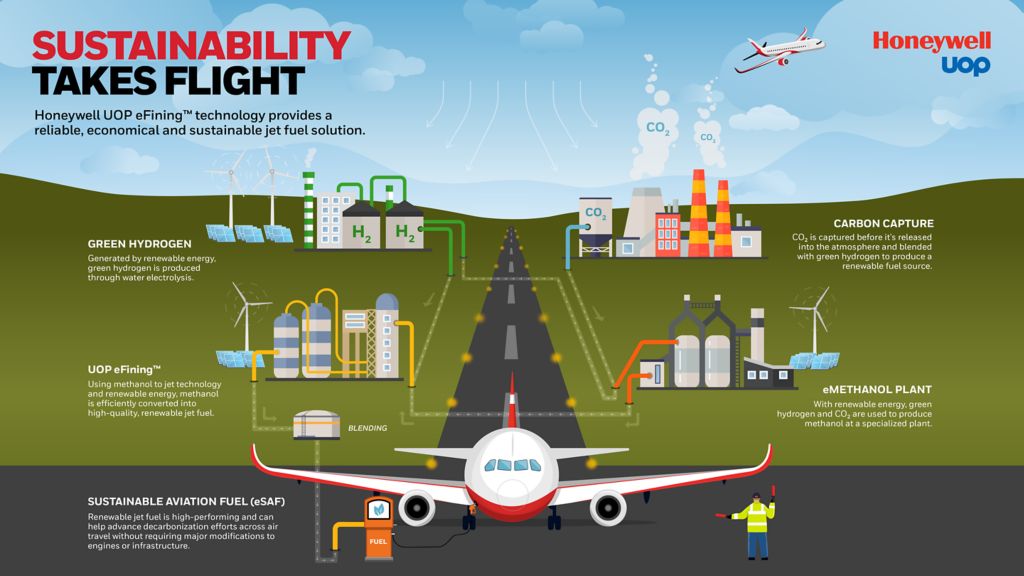UOP Link
The Sky Is Not the Limit
To reconcile the growing demand for air travel with increasing calls for decarbonization, the world needs greater and faster access to sustainable aviation fuel. Honeywell UOP eFiningTM technology enables rapid access to one of the most abundant renewable feedstocks on earth: CO2.
Produced using renewable energy, the combination of captured CO2 and hydrogen generates eFuel, or electrofuel, a lower carbon intensity alternative to traditional fuels. In the case of UOP eFining, eMethanol is used to create jet fuel that is ready to use today.

Why UOP?
As a trailblazer in renewable fuel technology, Honeywell UOP enables broad flexibility of feedstock supplies for sustainable aviation fuel, diesel and other renewable fuels. Leveraging 37 years of combined operating experience in methanol to olefins conversion, Honeywell UOP eFining is the latest in a line of technologies driving decarbonization in the aviation sector. Honeywell UOP offers multiple routes to market using a variety of feedstocks, including Ecofining™ technology (utilizing fats, oils and greases), the recently launched ethanol to jet technology and UOP eFining using eMethanol from green hydrogen and recycled CO2.
How eFining Technology Works
Honeywell UOP eFining provides a reliable, scalable and economical solution for customers who aim to produce eFuels that meet CO2 reduction and fuel sustainability targets while also taking advantage of available government incentives.2

eFuels have the potential to significantly reduce emissions from aviation.1 Renewable energy sources power the conversion of CO2 and hydrogen into liquid eFuels that are sustainable, high-performing and can be implemented into existing aircraft without requiring major modifications to engines or infrastructure.
eFining Key features and benefits
✔ Low carbon intensity jet fuel
✔ High SAF yield and selectivity
✔ Minimized CAPEX and plot space
✔ Scalable process with high operational reliability
✔ Highly integrated design
✔ High-efficiency equipment
✔ Modular units available to accelerate execution
✔ Unmatched commercial and R&D experience

FAQs about eFuels & eSAF
What is eSAF?
- • Sustainable aviation fuel (SAF) is a blend of conventional jet fuel and renewable biofuel. eSAF is a blend of conventional jet fuel and eFuel. High-performing and ready-to-use, eSAF can help advance decarbonization efforts across air travel. Today, SAF is approved for use in aircraft when blended up to 50% with conventional jet fuel. The aviation sector is working to enable commercial flights using 100% SAF by 2030.
What are eFuels?
- • eFuels, also known as electrofuels, are a class of synthetic, sustainable fuels that displace conventionally produced fossil fuels. This process starts with renewable power from sources like wind, solar, and geothermal energy. Green hydrogen is produced using an electrolyzer powered with renewable energy to turn water into hydrogen and oxygen. The hydrogen is then combined with recycled CO2 to produce eMethanol, which is the feedstock for a wide range of renewable fuels including SAF, gasoline and diesel alternatives. eSAF can be blended with the traditional aviation fuel used today for drop-in-use in existing jet engines without any modifications.
What is eFuel made of?
- eFuel is made of hydrogen atoms from water and carbon atoms from carbon dioxide.
What is the difference between eFuels and other renewable fuels?
- • Most renewable fuels produced today are biofuels. Biofuels are made from renewable biological sources. Examples include the inedible fats, oils and greases used in Honeywell UOP’s Ecofining™ process, the woody biomass used in the RTP® pyrolysis process, and the corn- and sugarcane-derived ethanol used in our ethanol to jet process. In contrast, eFuels are synthesized from abundant inorganic compounds: H2 and CO2.
When will eFuels be available?
- The technology to produce eFuels, like Honeywell UOP eFining, is available today. While eFuels are not being produced at commercial scale today, legislation and research both indicate industrial scale eFuel production by 2030.
What are examples of eFuels?
- eFuels are generated from renewable energy, hydrogen, and carbon dioxide. In addition to eMethanol, eFuels include eGasoline, eDiesel, and eSAF (eKerosene).
Is eFuel better than electric?
- In the aviation sector, electric planes can help significantly reduce greenhouse gas emissions, especially when powered by renewable electricity. While current battery technology and research shows promise for enabling short-range air travel, long-range travel will likely require the use of energy-dense liquid fuels for the foreseeable future. Renewable biofuels and eFuels are therefore an important solution for decarbonizing air travel today, as they allow existing aircraft to run on less carbon intensive sources.
What are the benefits of eFuels?
- eSAF, and SAF in general, is an immediate, practical means to reduce CO2 emissions from aviation. In particular, it will be crucial for reducing emissions from long-haul flights, which require energy-dense fuels and have few viable alternatives.
- eFuels start from carbon dioxide that is already above-ground, while conventional fuels emit carbon into the atmosphere that was once stored underground.
- eFuels are synthesized from abundant compounds, meaning that there is more than enough feedstock available to supply global demand.
- eFuels are ready-now solutions that are compatible with existing engines and systems. This saves time and eliminates costs associated with new infrastructure or complicated processes.
What are the disadvantages of eFuels?
- eFuel production is expensive. eFuel production is based on new technologies like renewable power plants and electrolyzers, which are becoming less expensive as the technologies mature.
- Because eFules are an emerging technology, more global capacity must be deployed to supply the quantity of sustainable fuel needed to reduce greenhouse gas emissions in the aviation sector.
